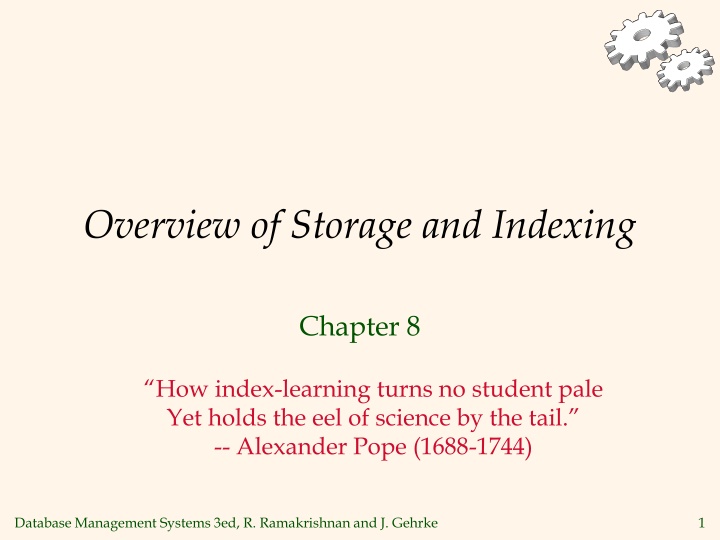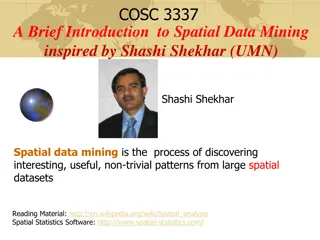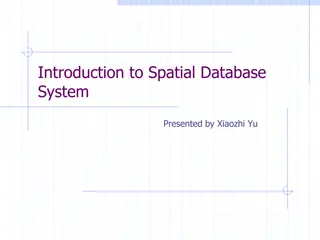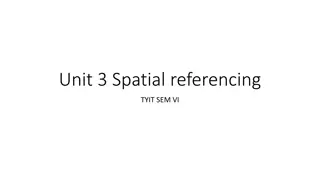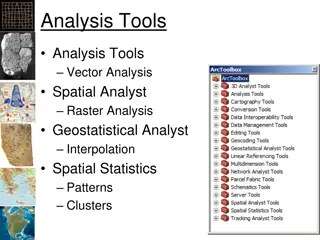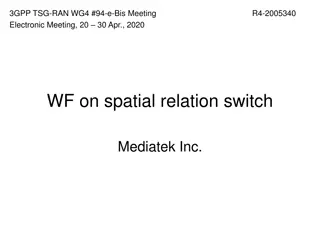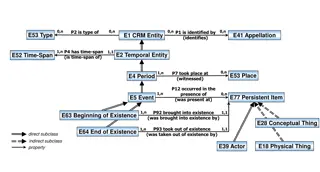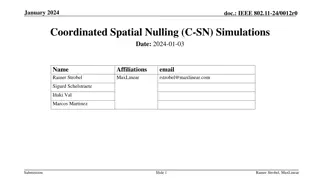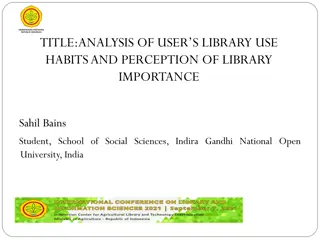Enhancing Spatial Data Analysis with SpaPy Library
The need for a reliable Python library for handling diverse spatial data tasks has led to the creation of SpaPy. Developed over the past 5 years, SpaPy offers support for shapefiles, various raster formats, and GeoJSON, along with standard geospatial processing, analysis, and data visualization capabilities. Discover how SpaPy simplifies complex tasks in spatial programming.
Download Presentation

Please find below an Image/Link to download the presentation.
The content on the website is provided AS IS for your information and personal use only. It may not be sold, licensed, or shared on other websites without obtaining consent from the author.If you encounter any issues during the download, it is possible that the publisher has removed the file from their server.
You are allowed to download the files provided on this website for personal or commercial use, subject to the condition that they are used lawfully. All files are the property of their respective owners.
The content on the website is provided AS IS for your information and personal use only. It may not be sold, licensed, or shared on other websites without obtaining consent from the author.
E N D
Presentation Transcript
Overview of Storage and Indexing Chapter 8 How index-learning turns no student pale Yet holds the eel of science by the tail. -- Alexander Pope (1688-1744) Database Management Systems 3ed, R. Ramakrishnan and J. Gehrke 1
Recall (Ch.1): Structure of a DBMS Query Optimization and Execution Relational Operators Files and Access Methods File organization Buffer Management Disk Space Management Actual data on disk DB Database Management Systems 3ed, R. Ramakrishnan and J. Gehrke 2
Data on External Storage Disks: Can retrieve random page at fixed cost But reading several consecutive pages is much cheaper than reading them in random order Tapes: Can only read pages in sequence Cheaper than disks; used for archival storage File organization: Method of arranging a file of records on external storage. Record id (rid) is sufficient to physically locate record Indexes are data structures that allow us to find the record ids of records with given values in index search key fields Architecture: Buffer manager stages pages from external storage to main memory buffer pool. File and index layers make calls to the buffer manager. Database Management Systems 3ed, R. Ramakrishnan and J. Gehrke 3
Alternative File Organizations Many alternatives exist, each ideal for some situations, and not so good in others: Heap (random order) files: Suitable when typical access is a file scan retrieving all records. Sorted Files: Best if records must be retrieved in some order, or only a `range of records is needed. Indexes: Data structures to organize records via trees or hashing. Like sorted files, they speed up searches for a subset of records, based on values in certain ( search key ) fields Updates are much faster than in sorted files. Database Management Systems 3ed, R. Ramakrishnan and J. Gehrke 4
Indexes An index on a file speeds up selections on the search key fields for the index. Any subset of the fields of a relation can be the search key for an index on the relation. Search key is not the same as key (minimal set of fields that uniquely identify a record in a relation). An index contains a collection of data entries, and supports efficient retrieval of all data entries k* with a given key value k. Database Management Systems 3ed, R. Ramakrishnan and J. Gehrke 5
Alternatives for Data Entry k* in Index Three alternatives: Data record with key value k <k, rid of data record with search key value k> <k, list of rids of data records with search key k> Choice of alternative for data entries is orthogonal to the indexing technique used to locate data entries with a given key value k. Examples of indexing techniques: B+ trees, hash- based structures Typically, index contains auxiliary information that directs searches to the desired data entries Database Management Systems 3ed, R. Ramakrishnan and J. Gehrke 6
Index Classification Primary vs. secondary: If search key contains primary key, then called primary index. Unique index: Search key contains a candidate key. Clustered vs. unclustered: If order of data records is the same as, or `close to , order of data entries, then called clustered index. Alternative 1 implies clustered; in practice, clustered also implies Alternative 1 (since sorted files are rare). A file can be clustered on at most one search key. Cost of retrieving data records through index varies greatly based on whether index is clustered or not! Database Management Systems 3ed, R. Ramakrishnan and J. Gehrke 7
INDEX DATA STRUCTURE HASHING and B+ Trees Database Management Systems 3ed, R. Ramakrishnan and J. Gehrke 8
Hash-Based Indexes Good for equality selections. Index is a collection of buckets. Bucket = primary page plus zero or more overflow pages. Hashing functionh: h(r) = bucket in which record r belongs. h looks at the search key fields of r. If Alternative (1)is used, the buckets contain the data records; otherwise, they contain <key, rid> or <key, rid-list> pairs. Database Management Systems 3ed, R. Ramakrishnan and J. Gehrke 9
Hashing (review 1/4) Key Information Hash Functio n Hash Table K1, K2, K3, .. h(key) : Get its position in hash table Records in hash table Given a key Database Management Systems 3ed, R. Ramakrishnan and J. Gehrke 10
Hashing (review 2/4) Hashing: The process of mapping a key value to a position in a table. A hash function h maps key values to positions. A hash table HT is an array that holds the records. HT has M buckets, (each with N slots), indexed form 0 to M-1. Database Management Systems 3ed, R. Ramakrishnan and J. Gehrke 11
B+ Tree Indexes Non-leaf Pages Leaf Pages Leaf pages contain data entries, and are chained (prev & next) Non-leaf pages contain index entries and direct searches: index entry P0 K1 P1 K2 Pm P2 Km Database Management Systems 3ed, R. Ramakrishnan and J. Gehrke 12
Tree Indexing (2) Difficulties when storing tree index on disk: Tree must be balanced for efficient searches. Each path from root to leaf should cover few disk pages. BST can be used but with difficulty to maintain balance, affecting too many blocks: Inserting 1 Database Management Systems 3ed, R. Ramakrishnan and J. Gehrke 13
2-3 Tree (1) FYI A 2-3 Tree has the following properties: 1. A node contains one or two keys 2. Every internal node has either two children (if it contains one key) or three children (if it contains two keys). 3. All leaves are at the same level in the tree, so the tree is always height balanced. The 2-3 Tree has a search tree property analogous to the BST. Database Management Systems 3ed, R. Ramakrishnan and J. Gehrke 14
Example B+ Tree Root 17 Entries <= 17 Entries > 17 27 5 13 30 33* 34* 38* 39* 2* 3* 5* 7* 8* 22* 24* 27* 29* 14* 16* Find 28*? 29*? All > 15* and < 30* Insert/delete: Find data entry in leaf, then change it. Need to adjust parent sometimes. And change sometimes bubbles up the tree Database Management Systems 3ed, R. Ramakrishnan and J. Gehrke 15
Cost Model for Our Analysis We ignore CPU costs, for simplicity: B: The number of data pages R: Number of records per page D: (Average) time to read or write disk page Measuring number of page I/O s ignores gains of pre-fetching a sequence of pages; thus, even I/O cost is only approximated. Average-case analysis; based on several simplistic assumptions. * Good enough to show the overall trends! Database Management Systems 3ed, R. Ramakrishnan and J. Gehrke 16
Comparing File Organizations Heap files (random order; insert at eof) Sorted files, sorted on <age, sal> Clustered B+ tree file, Alternative (1), search key <age, sal> Heap file with unclustered B + tree index on search key <age, sal> Heap file with unclustered hash index on search key <age, sal> Database Management Systems 3ed, R. Ramakrishnan and J. Gehrke 17
Operations to Compare Scan: Fetch all records from disk Equality search Range selection Insert a record Delete a record Database Management Systems 3ed, R. Ramakrishnan and J. Gehrke 18
Assumptions in Our Analysis Heap Files: Equality selection on key; exactly one match. Sorted Files: Files compacted after deletions. Indexes: Alt (2), (3): data entry size = 10% size of record Hash: No overflow buckets. 80% page occupancy => File size = 1.25 data size Tree: 67% occupancy (this is typical). Implies file size = 1.5 data size Database Management Systems 3ed, R. Ramakrishnan and J. Gehrke 19
Cost of Operations (a) Scan (b) Equality (c ) Range (d) Insert (e) Delete (1) Heap (2) Sorted (3) Clustered (4) Unclustered Tree index (5) Unclustered Hash index * Several assumptions underlie these (rough) estimates! Database Management Systems 3ed, R. Ramakrishnan and J. Gehrke 20
Cost of Operations (a) Scan (b) Equality (c ) Range (d) Insert (e) Delete (1) Heap BD 0.5BD BD 2D Search +D Search +BD Search +D Search + 2D Search + 2D (2) Sorted BD Dlog 2B Dlog 2 B + # matches Search + BD Search + D D(3 + log F 0.15B) 4D (3) Clustered 1.5BD Dlog F 1.5B Dlog F 1.5B + # matches Dlog F 0.15B + # matches BD (4) Unclustered Tree index (5) Unclustered Hash index BD(R+0.15) D(1 + log F 0.15B) 2D BD(R+0.1 25) * Several assumptions underlie these (rough) estimates! Database Management Systems 3ed, R. Ramakrishnan and J. Gehrke 21
Understanding the Workload For each query in the workload: Which relations does it access? Which attributes are retrieved? Which attributes are involved in selection/join conditions? How selective are these conditions likely to be? For each update in the workload: Which attributes are involved in selection/join conditions? How selective are these conditions likely to be? The type of update (INSERT/DELETE/UPDATE), and the attributes that are affected. Database Management Systems 3ed, R. Ramakrishnan and J. Gehrke 22
Choice of Indexes What indexes should we create? Which relations should have indexes? What field(s) should be the search key? Should we build several indexes? For each index, what kind of an index should it be? Clustered? Hash/tree? Database Management Systems 3ed, R. Ramakrishnan and J. Gehrke 23
Choice of Indexes (Contd.) One approach: Consider the most important queries in turn. Consider the best plan using the current indexes, and see if a better plan is possible with an additional index. If so, create it. Obviously, this implies that we must understand how a DBMS evaluates queries and creates query evaluation plans! For now, we discuss simple 1-table queries. Before creating an index, must also consider the impact on updates in the workload! Trade-off: Indexes can make queries go faster, updates slower. Require disk space, too. Database Management Systems 3ed, R. Ramakrishnan and J. Gehrke 24
Index Selection Guidelines Attributes in WHERE clause are candidates for index keys. Exact match condition suggests hash index. Range query suggests tree index. Clustering is especially useful for range queries; can also help on equality queries if there are many duplicates. Multi-attribute search keys should be considered when a WHERE clause contains several conditions. Order of attributes is important for range queries. Such indexes can sometimes enable index-only strategies for important queries. For index-only strategies, clustering is not important! Try to choose indexes that benefit as many queries as possible. Since only one index can be clustered per relation, choose it based on important queries that would benefit the most from clustering. Database Management Systems 3ed, R. Ramakrishnan and J. Gehrke 25
Examples of Clustered Indexes SELECT E.dno FROM Emp E WHERE E.age>40 B+ tree index on E.age can be used to get qualifying tuples. How selective is the condition? Choices: If E.age>40 not selective: sequential search will do as well as clustered If E.age>40 selective, then clustered will do much better due to faster access on age. Database Management Systems 3ed, R. Ramakrishnan and J. Gehrke 26
Examples of Clustered Indexes SELECT E.dno, COUNT (*) FROM Emp E WHERE E.age>10 GROUP BY E.dno Consider the GROUP BY query. If many tuples have E.age > 10, using E.age index and sorting the retrieved tuples may be costly. Clustered E.dno index may be better! Basically select the index for the attribute that gives higher Database Management Systems 3ed, R. Ramakrishnan and J. Gehrke selectivity 27
Examples of Clustered Indexes SELECT E.dno FROM Emp E WHERE E.hobby=Stamps Equality queries and duplicates: Clustering on E.hobby helps if many people collect stamps. Unclustered works ok if only one (or few) has the bobby. Database Management Systems 3ed, R. Ramakrishnan and J. Gehrke 28
Indexes with Composite Search Keys Composite Search Keys: Search on a combination of fields. Equality query: Every field value is equal to a constant value. E.g. wrt <sal,age> index: age=20 and sal =75 Range query: Some field value is not a constant. E.g.: age =20; or age=20 and sal > 10 Data entries in index sorted by search key to support range queries. Lexicographic order, or Spatial order. Examples of composite key indexes using lexicographic order. 11,80 11 12 12,10 nameage sal 12,20 12 13,75 bob cal 12 10 80 13 <age, sal> 11 <age> joe 12 20 10,12 sue 13 75 10 20 75 20,12 75,13 Data records sorted by name 80,11 80 <sal, age> Data entries in index sorted by <sal,age> <sal> Data entries sorted by <sal> Database Management Systems 3ed, R. Ramakrishnan and J. Gehrke 29
Composite Search Keys To retrieve Emp records with age=30 ANDsal=4000, an index on <age,sal> would be better than an index on age or an index on sal. Choice of index key orthogonal to clustering etc. If condition is: 20<age<30 AND 3000<sal<5000: Clustered tree index on <age,sal> or <sal,age> is best. If condition is: age=30 AND 3000<sal<5000: Clustered <age,sal> index much better than <sal,age> index! Composite indexes are larger, updated more often. Database Management Systems 3ed, R. Ramakrishnan and J. Gehrke 30
Index-Only Plans A number of queries can be answered without retrieving any tuples from one or more of the relations involved if a suitable index is available. SELECT D.mgr, E.eid FROM Dept D, Emp E WHERE D.dno=E.dno SELECT E.dno, COUNT(*) FROM Emp E GROUP BY E.dno SELECT E.dno, MIN(E.sal) FROM Emp E GROUP BY E.dno SELECTAVG(E.sal) FROM Emp E WHERE E.age=25 AND E.sal BETWEEN 3000 AND 5000 <E.dno,E.eid> Tree index! <E.dno> <E.dno,E.sal> Tree index! <E. age,E.sal> or <E.sal, E.age> Tree! Database Management Systems 3ed, R. Ramakrishnan and J. Gehrke 31
Index-Only Plans (Contd.) Index-only plans are possible if the key is <dno,age> or we have a tree index with key <age,dno> Which is better? What if we consider the second query? SELECT E.dno, COUNT (*) FROM Emp E WHERE E.age=30 GROUP BY E.dno SELECT E.dno, COUNT (*) FROM Emp E WHERE E.age>30 GROUP BY E.dno Database Management Systems 3ed, R. Ramakrishnan and J. Gehrke 32
Summary Many alternative file organizations exist, each appropriate in some situation. If selection queries are frequent, sorting the file or building an index is important. Hash-based indexes only good for equality search. Sorted files and tree-based indexes best for range search; also good for equality search. (Files rarely kept sorted in practice; B+ tree index is better.) Index is a collection of data entries plus a way to quickly find entries with given key values. Database Management Systems 3ed, R. Ramakrishnan and J. Gehrke 33
Summary (Contd.) Data entries can be actual data records, <key, rid> pairs, or <key, rid-list> pairs. Choice orthogonal to indexing technique used to locate data entries with a given key value. Can have several indexes on a given file of data records, each with a different search key. Indexes can be classified as clustered vs. unclustered, primary vs. secondary, and dense vs. sparse. Differences have important consequences for utility/performance. Database Management Systems 3ed, R. Ramakrishnan and J. Gehrke 34
Summary (Contd.) Understanding the nature of the workload for the application, and the performance goals, is essential to developing a good design. What are the important queries and updates? What attributes/relations are involved? Indexes must be chosen to speed up important queries (and perhaps some updates!). Index maintenance overhead on updates to key fields. Choose indexes that can help many queries, if possible. Build indexes to support index-only strategies. Clustering is an important decision; only one index on a given relation can be clustered! Order of fields in composite index key can be important. Database Management Systems 3ed, R. Ramakrishnan and J. Gehrke 35
BACKUP Database Management Systems 3ed, R. Ramakrishnan and J. Gehrke 36
Alternatives for Data Entries (Contd.) FYI Alternative 1: If this is used, index structure is a file organization for data records (instead of a Heap file or sorted file). At most one index on a given collection of data records can use Alternative 1. (Otherwise, data records are duplicated, leading to redundant storage and potential inconsistency.) If data records are very large, # of pages containing data entries is high. Implies size of auxiliary information in the index is also large, typically. Database Management Systems 3ed, R. Ramakrishnan and J. Gehrke 37
Alternatives for Data Entries (Contd.) FYI Alternatives 2 and 3: Data entries typically much smaller than data records. So, better than Alternative 1 with large data records, especially if search keys are small. (Portion of index structure used to direct search, which depends on size of data entries, is much smaller than with Alternative 1.) Alternative 3 more compact than Alternative 2, but leads to variable sized data entries even if search keys are of fixed length. Database Management Systems 3ed, R. Ramakrishnan and J. Gehrke 38
Hashing (review 3/4) FYI For any value K in the key range and some hash function h, h(K) = i, 0 <= i < M, such that key(HT[i]) = K. Hashing is appropriate only for no duplicate key Good for both in-memory and disk-based applications. Answers the question What record, if any, has key value K? Not suitable for range searches, finding records with min or max key, visit records in key order. Use Indexing Database Management Systems 3ed, R. Ramakrishnan and J. Gehrke 39
Bucket Hashing (review 4/4) FYI Groups hash table slots into buckets. Example: 8 slots/bucket, M=10 9 1 10 2 Include an overflow bucket. 3 Records hash to the first slot of the bucket, and fill bucket. Go to overflow if necessary. Home Position 4 Overflow Bucket When searching, first check the proper bucket. Then check the overflow. Expensive if overflow bucket contains many records If stored on disk: set bucket size to a disk block: one disk access/op 5 6 7 1 Bucket 8 Database Management Systems 3ed, R. Ramakrishnan and J. Gehrke 40
Tree Indexing (1) FYI Linear index is poor for insertion/deletion. Tree index can efficiently support all desired operations: Insert/delete Multiple search keys (multiple indices) Key range search Database Management Systems 3ed, R. Ramakrishnan and J. Gehrke 41
2-3 Tree (2) FYI The advantage of the 2-3 Tree over the BST is that it can be updated at low cost. Database Management Systems 3ed, R. Ramakrishnan and J. Gehrke 42
